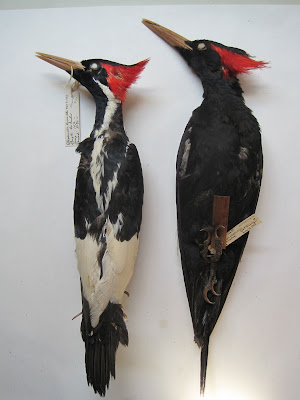Imperial Woodpecker - Part II


As I had promised, here are some woodpecker specimens from the Field Museum collections. I went in yesterday to work my usual post in the prep lab making study skins. Dave Willard (collections manager) kindly assisted in locating the Imperial and Ivory-billed study skins that you see above. Both specimens are very old, and both species are most likely extinct at this point. The woodpecker on the right is an Imperial, and on the left is the Ivory-billed; both are very large birds. The Ivory-billed is about the size of a very large crow, to give you some idea. Both birds belong to the genus Campephilus. They needed large swaths of old growth habitat with the Imperial occupying montane pine forests of Mexico, and the Ivory-billed living in pinewood and tupelo swamps of the southern United States. The Ivory-billed is often confused with the Pileated Woodpecker, a similar looking species. Although sharing similar habitat and looks, the Pileated belongs to the genus Dryocopus.
The Pileated is quite common in areas of older forest growth, while the Ivory-billed is a ghost that most likely just haunts our collective human psyche rather than the swamplands it used to inhabit.

Amazing! Thanks for sharing.
ReplyDeleteThey are gorgeous. It is sad to think that they could be extinct.
ReplyDeleteThank you for this unique and wonderful peek into the Field's collection!
ReplyDeleteIt must be quite something to see those close up. Such large birds, I only know the little ones(woodpeckers) and imagining that so much bigger, Wow.Thank-you.
ReplyDeleteLove this post! You're lucky to have your wishes granted by Dave Willard -- a kindred spirit in keeping the legacy of these lovely birds alive.
ReplyDeletethey're quite beautiful, but I have to confess, I find it a bit distressing to see them lying dead like this. I think I'm probably being too sensitive though :)
ReplyDeletep.s. have I mentioned before how lovely I think your work is?
ReplyDelete@ Hila - thanks for visiting! You are not being too sensitive. These are definitely sensitive objects, with complicated histories. While I work around them, and admire them for their beauty (both as art objects, and as animals), and for their scientific value, I do grapple with the issues they represent; not the least of which is that they are dead. I am hoping to address this directly in an upcoming post. : )
ReplyDeletediana: that sounds like the making of a fascinating post, can't wait to read it.
ReplyDelete